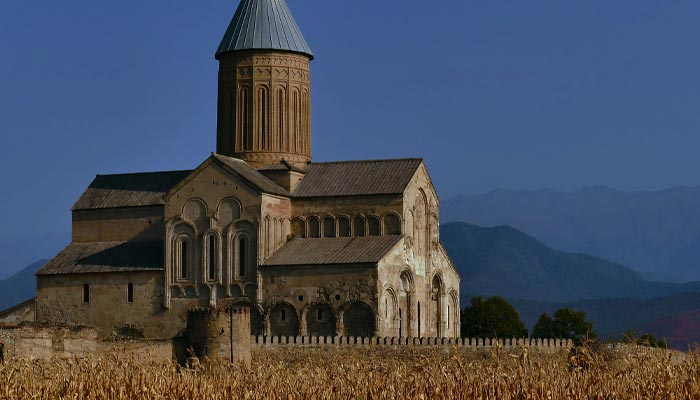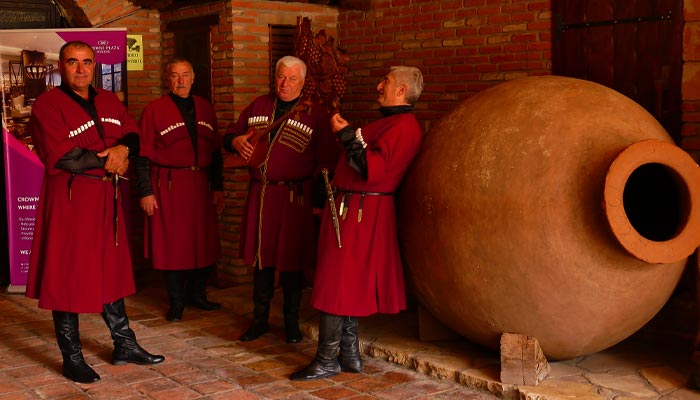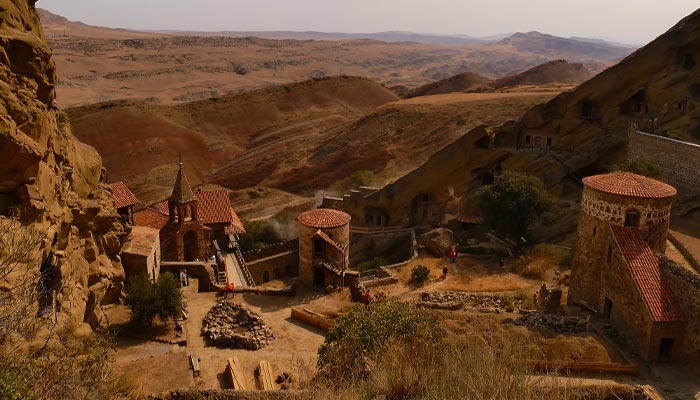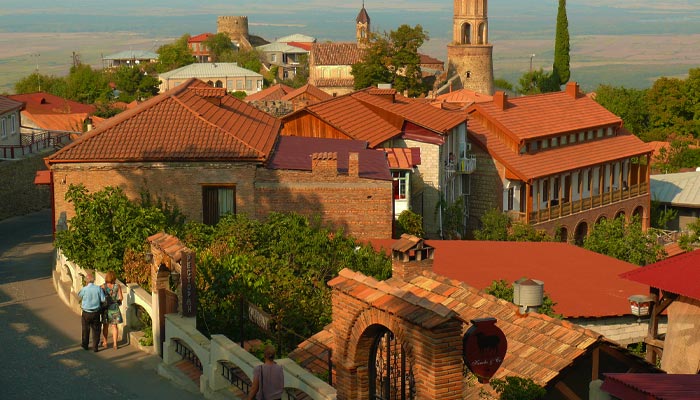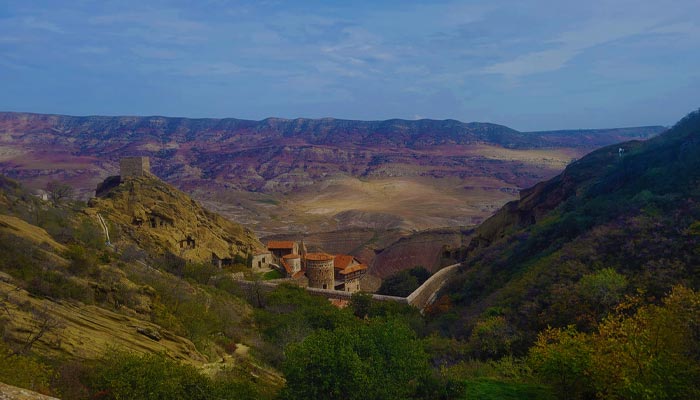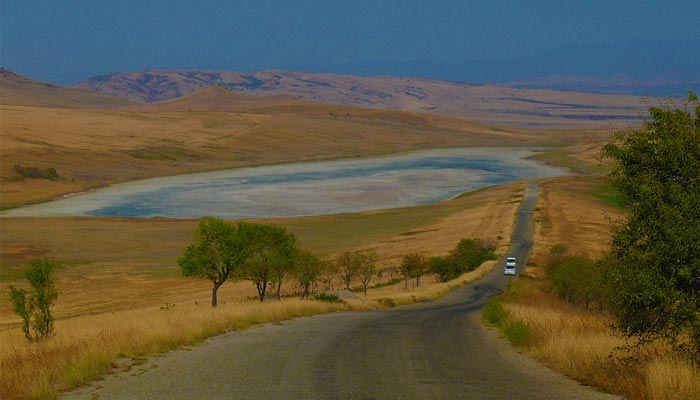|
Kakheti Kakheti is Georgia's best-known wine region, with a wide range of grape varieties grown and wines made using the ancient Georgian method of Qvevris. But Kakheti has much more to offer than wine, and is worth at least a day trip. If you are interested in medieval cultural monuments, Kakheti has around 1500 castles, fortresses, monasteries and churches painted with beautiful frescoes. If you are more interested in hiking, trekking or outdoor activities in general, Kakheti is the place to be as there are several national parks with great hiking routes. Kakheti's varied cuisine is also highly regarded in Georgia. Gourmets, especially meat lovers, will have a lot to discover in Kakheti. Lots of lamb, beef and pork are cooked in the region, using lots of fresh herbs and vegetables. What would good food and excellent wine be without beautiful singing? Kakheti is famous for its polyphonic singing with three or four independent voices. Kakheti is an administrative region in eastern Georgia and the name of the former kingdom in the area. Administratively, Kakheti today also includes the historical-geographical region of Tusheti. General information Area: 11,309.5 km² Name and structure of the administrative region The Kakheti region is named after Kakhos, the son of the mythological ancestor of Georgia, Kartlos. The administrative region of Kakheti also includes the historical region of Tusheti and consists of a total of 9 cities and 276 villages. Cultural and scenic highlights No other region offers as much cultural and scenic diversity and contrast as Kakheti. Here is a short list of the most important cultural monuments and scenic features of the region: 1. Alaverdi Cathedral The main landscape features of the region are: 1. Lagodechi National Park Cuisine in Kakheti Kakheti also differs from other regions of Georgia in its cuisine. Kakhetian specialities are mainly meat dishes, but they are very well seasoned and often served with vegetables, so that even non-meat lovers can enjoy the tasty dishes of Kakheti. Here is a small selection of particularly tasty Kakhetian specialities: 1. Khashlama - boiled beef with parsley Wines of Kakheti The wines of Kakheti are pressed in Qvevri (clay pots) sunk into the ground. This ancient method of winemaking dates back to the 6th millennium BC and was declared a UNESCO Intangible Cultural Heritage Site in 2013. These traditional top-quality wines, which require a great deal of expertise and physical labour, are produced not only in large wine cellars but in almost every Kakhetian family. Most popular Kakhetian wines: Tsinandali - A dry white wine. It is a blend of Rkatsiteli and Mtsvane grapes. Qisi - a dry white wine made from the grape variety of the same name, with light notes of dried fruit and black pepper. Rkatsiteli - dry white wine made from the most common grape variety in Kakheti, Rkatsiteli. The wine is reminiscent of Welschriesling or Sauvignon Blanc and should be drunk young. Kakhuri Mtsvane - a high quality and very aromatic white wine, often made as a dessert wine or sparkling wine. It is often blended with other wines. Saperavi - A very intense dry red wine. The flavour is reminiscent of blackberry, overripe cornelian cherry and a little dried cherry plum. Mukuzani - A dry red wine made from Saperavi grapes in Mukuzani, Kakheti. Mukuzani differs from other wines made from the same grapes in that it is aged for longer, at least three years, in oak barrels. It is important to know that traditional Georgian wines, especially white wines, have a different colour, aroma and taste than wines made according to the European method. Grape varieties in Kakheti Favoured by soil conditions, a mild climate and long growing seasons, numerous white and red grape varieties thrive in Kakheti, meeting the highest demands. Around 200 different grape varieties grow in this region alone, the most common of which are: 1. Rkatsiteli - the name means 'red horn'. It originates from Kakheti and grows mainly there, but is also widespread in Ukraine, Romania, Moldova and Bulgaria. The vines are late in sprouting and ripening, but they produce a high must weight and can retain very high acidity. The dry white wine of the same name is made from this variety. 2. Kakhuri Mtsvane - 96% of this variety is grown in Kakheti, mainly between the villages of Sagaredscho and Telavi. The grapes are used to make a very high-quality white wine of the same name. 3. Khikhvi - ripens in mid-September and has a high sugar content, around 23.0-24.0%. It is used to make dry white wines according to the Georgian method and mostly dessert wines according to the European method. 4) Kakhuri Mcivani - A very special autochthonous grape variety that produces high quality, aromatic dry white wines. The variety was neglected during the Soviet era due to its relatively low must content and need for extensive care, but there is currently a great demand for Kakhuri Mcivani wines and it is on the rise again. The name translates as: "Cold sensitive from Kakheti". 5. Saperavi - A classic variety that grows throughout Georgia but ripens best in Kakheti. It generally ripens very late and is resistant to powdery mildew, downy mildew and frost. Translated, Saperavi means dyer's grape. Even when blended with 30% white wine, the resulting wines are still bright red in colour. Polyphonic songs in Kakheti Kakheti is also known for its polyphonic songs. The most popular songs include "Mravaljamieri" and "Chakrulo". Mravaljamieri - is a polychronion and can be translated as "Many years" or "Long live...". It is a solemn song of praise sung in the liturgy or for the community of Orthodox Christianity, as well as for individuals on special occasions such as weddings, births, etc. Chakrulo - a classical polyphonic song in three parts. The song is part of UNESCO's Intangible Cultural Heritage and was sent to the Alps along with 28 other compositions of humanity. The country's best interpreter of polyphonic songs was Hamlet Gonashvili, born in Kakheti, in the village of Anaga, also known as "the voice of Georgia". Regional festivals There are several traditional folk festivals in Kakheti, related to the turbulent history of Kakheti, to religion, to the special humour of Kakheti, or to the Kakhetian sacred vine. Alaverdoba - takes place at the end of September in the Alaverdi Monastery and lasts several days. It celebrates the foundation of the Alaverdi Monastery and the day of its founder, Iosef Alaverdeli. Zezwaoba - is also held at the end of September and commemorates the national hero Zezva Gafrindauli, who played a decisive role in the liberation of Kakheti from the Persians in the 17th century. A special liturgy is held in the village of Alwani. A poetry festival called "Kafiaoba" is held every year in May in the valley of Ilto. Anyone of any age can recite a poem. The aim of the festival is to create proximity to the audience in an unconventional way, where professional or amateur artists can recite their poems in their local dialects. At the end of the poetry session, there is a concert of folklore typical of the country. The festival also serves to revive the abandoned villages of the valley. Rtveli/grape harvest festival - it may not be an official festival, but in Kakheti the grape harvest festival is more important than New Year or Christmas in some countries. For the people of Kakheti, the vine is a member of the family and is cared for in the same way as their own children. During the grape harvest, from the end of September to around mid-October, the whole region is transformed into a cheerful and happy world. There are concerts organised by the town councils, but after a hard day's work every family celebrates with singing, dancing and toasting. The beginning of the grape harvest is also felt in the capital and many people go to Kakheti to be part of this happy world for a few days. Interesting tradition and the grapevines - In spring, when the vines are budding, families bake special buns with cheese. Family members take the rolls, candles and wine and go to their vineyard. The buns are placed in the four corners of the vineyard with lit candles and the family begins to pray for a good harvest while drinking four glasses of wine. History of Kakheti Kakheti was first mentioned in the 3rd century BC. The Principality of Kakheti, with its administrative centre at Ujarma, became part of the newly formed Kingdom of Iberia. At that time, Kakheti comprised only a small area above the river Iori. Other regions, Kukheti and Hereti, which were later incorporated into Kakheti, initially functioned independently. In the 4th century, Georgia officially became Christian and King Mirian IV restructured his kingdom, dissolving the Principality of Kakheti and subordinating it to the neighbouring region of Kartli. Restoration of the Principality of Kakheti After most of the former kingdom of Iberia was occupied by the Arabs in the 8th century, Kakheti managed to retain its independence. The region also brought several neighbouring areas under its influence, and by the end of the 8th century the independent Principality of Kakheti was established. The Principality had a large income from its flourishing agriculture and livestock and strove for further expansion, but in the 10th century Kakheti was incorporated into united Georgia. Transition to kingdom In the 11th century, while the Georgian king Giorgi I was busy fighting Byzantium, Prince Kvirike III managed to gain independence for Kakheti, also obtaining the title of king from Byzantium and subsequently declaring his principality a kingdom. Telavi became the capital and economic centre of the new kingdom. Kakheti under united Georgia King Davit the Builder reunited Georgia in the early 12th century and Kakheti became part of the Georgian Kingdom. For the next almost 300 years, Kakheti was part of Georgia, sharing some very difficult but also peaceful times with other areas of the country. Kakheti again as an independent kingdom In the 15th century, shortly after the Ottomans had conquered Byzantium and Georgia had lost its most important ally, Giorgi VIII became king of a still united Georgia. He had many enemies, both foreign and domestic, and was defeated in a battle in 1463. However, he managed to escape to Kakheti, where he defeated the local princes and declared himself King of Kakheti. This is how the first king of the Bagrationi dynasty came to power in eastern Georgia and how the Kingdom of Kakheti was founded in the 15th century. Giorgi was the first Georgian king to send ambassadors to Europe to ask for help in the fight against the Ottomans, but the help did not come because the West did not want to worsen diplomatic relations with the Ottoman Empire. The next 150 years or so were largely characterised by the development and economic growth of Kakheti. In particular, Kakheti flourished under King Alexander I. Unlike his father, Alexander did not look far to Europe for help, but to Russia, and he was the first Georgian king to send embassies to Russia at the end of the 15th century. His grandson, Levan I, continued his grandfather's development work and expanded trade relations with Persia and other neighbouring countries. He built the city of Gremi and moved the capital of Kakheti there. The next king of Kakheti, Alexander II, was very talented in diplomacy, but he and the whole country had a great misfortune because at the beginning of the 16th century, Shah Abbas I came to power in Persia and his aim was not to bring Georgia under his influence, but simply to destroy the neighbouring Christian country. Between 1613 and 1617, Shah Abbas invaded eastern Georgia four times, almost completely destroying Kakheti. Some of the population managed to flee to the mountains, but most died in the fighting and those who survived were deported to Persia. Their descendants still live in the Persian province of Fereydan. After the Persian invasions, several kings tried to get Kakheti back on its feet, but it was not until the early 18th century, when Teimuraz II and later his son, Erekle II, came to power, that this was really successful. Erekle II regained lost territories and united two kingdoms, Kartlia and Kakheti. But he soon realised that his kingdom was no match for the Ottomans and Persians without foreign help, and in 1783 he signed a treaty with the Russian Tsarina Catherine II in which he agreed to recognise the Russian protectorate and put his forces at the service of the Russian Empire. Dissolution of the kingdom and annexation by Russia Despite the treaty, Russian help in the Persian invasion of 1795 did not materialise, although the war was triggered by Georgia's treaty and partnership with Russia. After the Persian invasion and the lost battle, the United Kingdom of Kartl-Kakheti was greatly weakened. In 1801, after the death of the last East Georgian king, Giorgi XII, the Kingdom of Kartl-Kakheti was finally dissolved and incorporated into Tsarist Russia. Kakheti during the Tsarist and Soviet periods The restive people of Kakheti could not get used to the occupation regime, new laws and Russification, and several large-scale uprisings followed between 1804 and 1812, as well as in 1832. The insurgents achieved some success, but were crushed each time. Shortly after the establishment of the Soviet regime in 1924, a large-scale uprising against the Bolsheviks began in Kakheti and soon involved almost the whole country, but the organisers of the uprising were soon arrested and the Soviets began a brutal crackdown throughout the country. Kakheti under independent Georgia In 1991, Georgia officially became an independent country and soon after, in 1995, the Georgian President issued a decree establishing the Kakheti Administrative Region as part of the whole of Georgia. On following trip, you will visit Kakheti |

